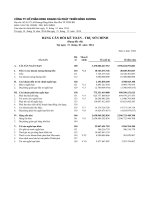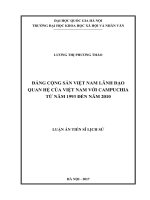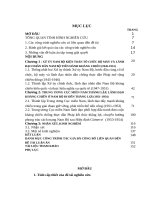Giáo án tiếng anh 9 sách thí điểm soạn cv 5512 (cả năm)
Bạn đang xem bản rút gọn của tài liệu. Xem và tải ngay bản đầy đủ của tài liệu tại đây (2.11 MB, 452 trang )
THE FIRST SEMESTER
Date of preparing : 01/9/2022
Date of teaching : 07/9/2022
Week 1
Period 01
REVISION
I.Objectives:
- By the end of this lesson, students will be able to:
1.Knowledge
+ remember about tenses, passive, indirect speech….
+ use tenses, passive, indirect speed to practice in the verb tenses, passive, indirect
speech,....
2.Skills :
+ identify how to use the verb tenses, passive, and indirect speed.
3.Attitude:
+Ss will be more responsible for and be more aware of the importance of learning English
+receive the difference from tenses, passive, indirect speech….
4. Competence development:
- Groupwork, independent working, pairwork, linguistic competence, cooperative learning
and communicative competence.
II. Preparation
-Teacher: Textbooks, exercise,computer accessed to the Internet, projector
-Students: Textbooks.
III. Procedure
1.Warmer
-Greeting.
1
-Checking attendance :
2.Revision:
- Ask Ss to repeat how to use the tenses, passive and indirect /reported speech….
3.New lesson
Exercise 1. Change the following sentences into Indirect / Reported Speech or viceversa
1. The doctor told him that he worked too hard.
“You..…………………
2. “I’m sorry I broke the glass”, said Peter.
Peter apologized.…………………
3. She asked John how he liked her new dress.
“How…...……………
4. “Why don’t you put your luggage under the seat?”, he asked.
He suggested………………………………………………………….……
5. “Keep away from this area”, said the security guard when we approached the fence.
The security guard told…………………………………………………
6. Isabel: “You can’t borrow my pen, Robert!”.
Isabel…...…………………
7. She asked John to repeat what he had said.
Please……..………
8. “I don’t want to be criticized by non-professionals”, said the film star.
The film star objected…..……………………………
9. “If I were you, I’d look for another job”, said one of my friends.
One of my friends…………………………………………………
10. She wanted to know if he had studied French.
She asked him, “…………
Key:
1. “You work too hard” the doctor said to him
2. Peter apologized to break the glass.
3. “How do you like my new dress ,John ?”
4. He suggested putting my bag under the seat./I put my bag….
2
5. The security guard tod us to keep away from that area.
6. Isabel said Robert couldn’t borrow her pen.
7. Please “what have you said?”/what did you say?”
8. The film star objected not to want to be criticized by non-professionals.
9. One of my friends said if she were me she would have looked for another job.
10.She asked him, “Have you studied French?”
Exercise 2. Rewrite the sentences so that it has the same meaning as the sentence
printed before.
1. It’s three years since we last visited Ha Noi. We haven’t visited HaNoi for 3 years.
2.No one is more intelligent than her in our school. She is the most intellegent in our
school.
3. You can’t take this book away.
This book can’t be taken away.
4. Huong is 1.60m tall and Hoa is 1.60m tall, too.
- Huong is as tall as Hoa./Huong has the same heigh as Hoa.
5.I wrote a letter half an hour.
It took me half an hour to write a letter.
6.She’s rather play golf than play tennis.
She prefers plaing golf to playing tennis.
I used to have a cat.
7. I had a cat once, but I don’t any more.
8.I couldn’t go to school because of my sickness. Because I was sick ,I couldn’t go to
school.
9.Your younger brother is too weak to lift that box.
- Your brother is not strong enough to lift that box.
10. I study English so that I can improve my knowledge.
- I study English so as to improve my knowledge.
Exercise 3. Change the following sentences into the passive:
1.Someone saw him pick up the gun.
He was seen to pick up the gun.
2.He has caught a lion and shot 2 others.
3
- A lion has been caught and 2 others have been shot by him.
3.He received a letter from his friend.
A letter from his friend was received by him.
4.I put the 5 pound note into one of my books yesterday.
- The 5 pound note was put into one of my book yesterday.
English is spoken all over the world.
5.People speak English all over the world.
6.We are learning English now . English is being learned now.
7.They will build a new surpermarket here. A new supermarket will be built here.
8.They were playing games at 4p.m yesterday. Games were being played at p.m
yesterday.
3.Homework :
-Redo all exercises above .
-Prepare for the next lesson: Unit 1: Getting started.
-Find the environment of craft villages in Viet Nam
_________________________________________________________
Date of preparing : 01/9/2022
Date of teaching : 08/9/2022
Week 1
Period 02
Unit 1: LOCAL ENVIRONMENT
Lesson 1 – Getting started : A visit to a traditional craft village
I.Objectives:
- By the end of this Unit, students will be able to:
1.Knowledge
+use the lexical items related to the topic traditional crafts and places of interest :
artisan,pottery,craft ,set up,workshop,take over,handicraft,conical hat.
+ listen and read for specific information about traditional craft villages.
4
2.Skills :
- Listening: Listen to the conversation among Nick, Mi and Phong, listen and do some
exercises.
- Reading: Read the conversation and then find the word and phrases that have the same
meaning and answer the following questions.
- Speaking: describe the leisure activity.
- Writing: Write the name of each traditional handicraft in the box under the picture
3.Attitude:
+Ss will be more responsible for and be more aware of the importance of Vietnamese
traditional craft villages.
4. Competence development:
+ Groupwork, independent working, pairwork, linguistic competence, cooperative learning
and communicative competence.
II . Preparation:
-Teacher: Textbooks, CD cassette player ,computer accessed to the Internet, projector
-Students: Textbooks.
III. Procedure:
1. Checking: During the lesson
2. New lesson:
Teacher’s & Students’ activities
The main contents
1. Warm up
Aim: To attract Ss’ attention to the lesson and to lead in the new lesson.
Chatting:
Ex: Bat Trang / Dong Ho /Dong Ki…village
-T: Can you name some craft villages in Viet
Nam ?
-Ss : answer the question
2. Presentation
5
Aim: Ss get the main idea of the conversation among Nick, Phong and Mi, then do some
exercises.
-Ask Sso open their books and look at the
picture and the phrase under GETTING
STARTED. Ask them some questions:
Who and what can you see in the picture?
Where are they?
What do you think the people in the picture
are talking about?
-Ss answer the questions as a class. If they
mention ‘Bat Trang’, elicit what they
know about this village.
1. Listen and read
* New words:
Play the recording and have Ss follow
along. After that, Ss can compare their
answers with the information in the
dialogue and add some more details to
their answers.
- piece (n): vật mẫu
- take over (v): tiếp quản
- artisan (n): thợ thủ công
a. Ss work independently to find the
words
- conical hat (n): nón
/phrases with the given meanings in the
dialogue.
- handicraft (n): đồ thủ công
-Allow Ss to share their answers before
asking them to discuss as a class.
a. Can you find a word/phrase that
means:
-Remember to ask Ss to read out the lines
in
the dialogue that contain the
words/phrases. Quickly write the correct
answers on the board.
1. craft
5. attraction
-Have Ss look at the Watch out! box and
quickly read the information. Tell them that
there are some similar expressions such as
2. set up
6. specific region
3. take over
7. remind
‘as far as I can remember’, ‘as far as I can
4. artisans
8. look round
6
see’, or ‘as far as I can tell’.
b. Have Ss read the questions to make
sure they understand them.
b. Answer the questions
1. They are at Phong’s grandparents’
workshop in Bat Trang.
-Ask them firstly to answer the questions
without reading the dialogue again.
2. It is about 700 years old.
-Ss exchange their answers with a
classmate.
3. His great-grandparents did.
-Now ask them to check their answers by
reading the dialogue again
4. Because people can buy things for their
house and make pottery themselves there.
5. It’s in Hue.
6. Because the handicrafts remind them of a
specific region.
3: Practice
Aim: SS get some new words/ their meaning and uses by completeing exercise 2& 3
-Have Ss look at the pictures. Tell Ss that in
the box are some traditional handicrafts of
different regions in Viet Nam. Ss write
these handicrafts under the pictures. Ss
compare their answers in pairs before
giving their answers to T.
2. Write the name of each
traditional handicraft in the box
under the picture.
- Tell Ss to complete the sentences with the
words/phrases in 2. The complete sentences
will give Ss information about the places
where the handicrafts are made. Call on
two Ss to write their answers on the board.
Confirm the correct answers.
Ss have to call out the place where this
handicraft is made. Ss can also be asked to
7
A. paintings
B. drums
C. marble
sculptures
D. pottery
E. silk
F. lacquerware
G. conical hats
H. lanterns
share any other places that produce these
handicrafts.
3. Complete the sentences with the
words/ phrases from 2 to show where in
Viet Nam the handicrafts are made. You
do not have to use them all.
1.conical hat
4. paintings
2. lanterns
5. pottery
3. silk
6. marble sculptures
4. Further practice
Aim: Help Ss develop speaking by doing the quiz.
a/ Ss work in pairs to do the quiz. The
pair which has the answers the fastest is
invited to read out their answers. Elicit
feedback from other pairs. Confirm the
correct answers.
III. Further practice:
b / Ss work in groups to write a similar
quiz about places of interest. Set a time
limit of about 4 minutes. When time is
up, ask the first group to read out a
question in their quiz. Ss from other
groups give the answer. The group
confirms the correct answer. The second
group then reads out a question in their
quiz. This question should be different
from the one of the first group. Continue
the activity until all the groups have read
out all of their questions or when time is
up.
1. park
2. museum
3. zoo
4. beach
4 QUIZ: WHAT IS
OF INTEREST?
THE PLACE
a. Work in pairs to do the quiz.
5. beauty spot
b. Work in groups. Write a similar
quiz about places of interest. Ask
another group to answer the quiz.
3. Guides for homework
-Practice reading the dialogue.
8
-Write new words then learn them by heart. artisan,pottery,craft ,set up,workshop,take
over,handicraft,conical hat.
-Copy the exercise into notebooks.
-Do exercise in workbook
-Prepare next lesson Unit 1: A CLOSER LOOK 1
_______________________________________________________________________
Date of preparing : 01/9/2022
Date of teaching : 09/9/2022
Week 1
Period 03
Unit 1: LOCAL ENVIRONMENT
Lesson 1 – A closer look 1
I.Objectives:
- By the end of this Unit, students will be able to:
1.Knowledge
+ use the lexical items related to traditional crafts and places of interest in an area: cast,
carve,embroider,weave,mould, knit .
+ say sentences with correct stress on the content words
2.Skills :
+Listening: Listen and answer the questions.
- Writing: write the verbs in the box.
+ practice pronouncing : sentences with correct stress on the content words
9
3.Attitude:
+Ss will be more responsible for and be more aware of the importance of Vietnamese
traditional craft villages.
4. Competence development:
+ Groupwork, independent working, pairwork, linguistic competence, cooperative learning
and communicative competence.
II . Preparation:
-Teacher: Textbooks, CD cassette player ,computer accessed to the Internet, projector
-Students: Textbooks.
III. Procedure:
1. Checking: During the lesson
2. New lesson:
Teacher’s & Students’ activities
The main contents
1. Warm up
Aim: To attract Ss’ attention to the lesson and to lead in the new lesson.
-Ask Ss to call out some traditional crafts
they remember from the previous lesson.
-Tell them that in this lesson they are going
to learn some verbs that are used to talk
about producing or creating a craft. These
will help them use the language correctly
when they talk about the making of
traditional crafts in a specific region.
- Introduce the new lesson
2. Presentation
Aim: Ss can know how to read some food preparation verbs and know its meaning.
- Pre- teach vocabulary: expression/ mine/
I. Vocabulary
10
visual aids/ translation/ situation
- T: writes new words on the board.
- embroider (v): thêu
- SS: listen and repeat in individual first then - cast (v): đúc
the whole class.
- weave (v): dệt
- Call 3- 4 SS to read the words again.
- mould (v): nặn
Checking: rub out and remember
-Ss work individually to do this exercise
and then compare their answers with a
classmate. Elicit the answers from Ss and
quickly write them on the board. Do not
confirm the correct answers at this stage.
Have Ss explain the meaning of each
verb in English or Vietnamese. Correct
Ss’ explanations when needed. The two
verbs cast and mould are quite difficult,
so make sure that Ss understand them:
- knit (v): đan
- carve (v): chạm, khắc
1/ Write the verbs in the box under
the pictures. One of them should be
used twice.
- cast: shape hot liquid metal, etc. by
pouring it into a container
A. cast
E. mould
B. carve
F. weave
C. embroider
G. knit
D.weave
- mould: shape a soft substance into a
particular form or object by pressing it or by
putting it into a mould Now have Ss look at
their answers on the board and say if these
are correct.
3. Practice
Aim : help Ss understand more deeply and use the verbs correctly to talk about
producing and creating crafts and practice on sentence stress
2 a. Ss work in pairs to do the exercise.
Check the answers as a class. If time
allows, have Ss make sentences.
2.a. Match the verbs in column A with
the groups of nouns in column B.
b. This activity will help Ss to manipulate
the verbs as they are not all regular.
11
1- b
2- d
3- e
4- a
5- f
6- c
Have Ss do the activity, then call two Ss to
write their answers on the board.
b. Now write the correct verb forms for
these verbs
2. cast- cast
3. wove- woven
3. Organise a competition for this activity.
Ss work in groups of five or six. Set a time
limit of five minutes.
T may prepare
some large pieces of paper for the groups to
write their answers on. Ss write down as
many places of interest in the word web as
possible. The group with the most places is
the winner. The winning group presents their
words/phrases. Other groups tick the similar
words/phrases they have and add more if
they can. If time allows, T may ask Ss to
explain why they think the places are
entertaining, cultural, educational, or
historical.
4. Ss individually do the exercise. Check
their answers as a class and confirm the
correct ones
4. embroidered- embroidered
5. knitted- knitted
6. moulded- moulded
3. What are some places of interest in
your area? Complete the word web. One
word can belong to more than one
category.
Suggested answers:
- Entertaining: cinema, department store,
restaurant, café, theatre, opera house, club,
park, zoo...
- Cultural: opera house, museum, craft
village, historical building, theatre, market,
craft village...
- Educational: library, museum, theatre...
- Historical: building, temple, shopping
district, market, beauty spot, craft village.
5 a/ Have Ss read the five sentences and
4. Complete the passage by filling each
blank with a suitable word from the
box.
12
underline the words they think are
stressed. Elicit answers from Ss. Do not
confirm the correct answers. Now ask Ss
to read the four questions and make sure
they understand them. Ask Ss to listen to
the speaker read the sentences and at the
same time check whether their answers are
correct. Tell them that this is actually the
first question and other questions can be
answered after listening. Ss discuss their
answers to the four questions in pairs.
1. historical
4. traditional
2. attraction
5. culture
3. exercise
6. handicrafts
II Pronunciation:
Stress on content words in sentences
5/ a Listen to the speaker read the
following sentences and answer the
questions.
b/ Call some Ss to give the answers and
give feedback. Play the recording again for
Ss to repeat the sentences. Have Ss read the
information in the box to remember the
content of the lesson.
1/
Sentence
1
craft, village, lies, river,
bank
Sentence
2
painting, embroidered
Sentence
3
What, region, famous
Sentence
4
drums, aren’t, made,
village
Sentence
5
famous, artisan, carved,
table, beautifully
2/ They are: nouns, verbs, adjectives,
adverbs, wh- questions words, and
negative auxiliaries
Sentence
1
3/ Sentence
2
13
The, on, the
This, is
Sentence
3
Is, this, for
Sentence
4
In, my
Sentence
5
A, this
4/ They are: articles, prepositions,
pronouns, and possessive adjectives
4. Further practice
Aim: Ss can practise reading the correct stress on content words in sentences
6/a Ss do this exercise individually and
compare their answers with a classmate.
6.a. Underline the content words in
the sentences.
b/ Play the recording for Ss to check their
answers and practise reading the
sentences. Call some Ss to give the
answers and read the sentences. Give
correction if needed.
1: Arts Museum, popular place, interest, city
2: cinema attracts, youngsters
3: artisans mould clay, make traditional pots
4: where, like going, weekends
5: shouldn’t destroy historical buildings
3. Guides for homework
-Write new words then learn them by heart: cast, carve,embroider,weave,mould, knit .
-Copy the exercise into notebooks.
- Do exercise A1, 2; B5 (P 3- 5 workbook)
-Prepare next lesson Unit 1 : A CLOSER LOOK 2
____________________________________________________________
14
Date of preparing : 04/9/2022
Date of teaching : 14/9/2022
Week 2
Period 04
Unit 1: LOCAL ENVIRONMENT
Lesson 2 – A closer look 2.
I.Objectives:
- By the end of this Unit, students will be able to:
1.Knowledge
+ Review complex sentences
+ Use some common phrasal verbs correctly and appropriately
2.Skills :
- Writing: Make complex sentences from each pair. Rewrite the sentences using phrasal
verbs; complete the sentences using phrasal verbs.
3.Attitude:
+Ss will be more responsible for and be more aware of the importance of Vietnamese
traditional craft villages.
4. Competence development:
+ Groupwork, independent working, pairwork, linguistic competence, cooperative learning
and communicative competence.
15
II . Preparation:
-Teacher: Textbooks, CD cassette player ,computer accessed to the Internet, projector
-Students: Textbooks.
III. Procedure:
1. Checking: During the lesson
2. New lesson:
Teacher’s & Students’ activities
The main contents
1. Warm up
Aim: To attract Ss’ attention to the lesson and to lead in the new lesson.
-Elicit from Ss what they still remember
about complex sentences.
- Have them make sentences with
although, when, so that, and because.
Give feedback and quickly write the
sentences on the board. Underline the
dependent clause with these subordinators.
-Tell Ss that today they are going to focus
on these dependent clauses.
-Now ask Ss to read the information in the
yellow box.
-When Ss have finished reading, ask them
to name the dependent clauses on the
board.
2. Presentation
Aims: Help SS to review about complex sentences and some phrasal verbs
1/ Ss do this exercise individually. Elicit
Ss’ answers. Confirm the correct ones.
I/ complex sentences:
E1/ Underline the dependent clause in
each sentence below. Saywhether it isa
dependent clause of concession (DC), of
16
purpose (DP), of reason (DR), or of
time (DT).
1DT
3/Ask Ss to read the sentences taken from
the conversation in GETTING STARTED,
paying attention to the two verb phrases.
Have them answer the two questions orally
as a class.
Have Ss read the information in the
yellow grammar box. Ask them to call
out any phrasal verbs they know and
write them on the board. Have them
explain the meaning of these verbs.
2DP
3DC
4DR
5DT
E3/ Read this part of the conversation
from GETTING STARTED. Pay
attention to the underlined part and
answer the questions.
1/
*set up: start something (a business, an
organisation, etc.)
* take over: take control of something (a
business, an organisation, etc.)
2/ No, the individual words in the verb
phrase do not help with comprehension.
This is why they are sometimes
considered difficult.
3. Practice
Aim: Help SS to use complex sentences and some phrasl verbs correctly.
2/Ss write the complex sentences
individually and then compare them with
a partner.
-Have two Ss write their sentences on the
board. Each student writes two or three
sentences.
-Ask other Ss to give feedback. Confirm
the correct answers.
E2/Make a complex sentence from
each pair of sentences. Use the
subordinator provided and make any
necessary changes.
1. The villagers are trying to learn English
in order that they can communicate with
foreign customers.
2. After we had eaten lunch, we went to
17
For a stronger class, organise a quick game.
One side is team A, and the other is team B.
One student from team A calls out a
subordinator and points to one student from
team B to make a sentence and vice versa.
Set a time limit and keep a record of the
scores for the teams on the board.
Non Nuoc marble village to buy some
souvenirs.
4/ Ss do this exercise individually, and then
compare their answers with a classmate.
Check Ss’ answers and confirm the correct
ones.
5. This is called a Chuong conical hat
since it was made in Chuong village.
3. Even though this hand-embroidered
picture was expensive, we bought it.
4. This department store is an attraction in
my city because the products are of good
quality.
E4/ Match the phrasal verbs in A
with their meaning in B.
5/ Ss do this exercise individually. Elicit
the answers and give correction
6/Have Ss quickly read the provided
sentences. Make sure they understand the
meaning of each sentence. Tell Ss that all
the phrasal verbs used in this exercise
have been presented in this lesson. Ss
write the sentences individually and then
compare their answers with a classmate.
Call on two Ss to write their sentences on
the board. Other Ss and T give feedback.
For a less able class, T may want to model
the first sentence. Ss may just focus on the
next two sentences. After two Ss write their
sentences on the board, check them
carefully. If there is no time left, ask Ss to
finish the remaining sentences as
homework.
1-c
3-f
5-h
7-e
2-g
4-a
6-b
8-d
E5/ Complete each sentence using
the correct form of a phrasal verb
in 4. You don’t need to use all the
verbs.
1/face up to
4/ live on
2/ turned down
5/ close down
3/Passed down
6/ did…. come
back
E6/ Complete the second sentence so
that it has a similar meaning to the
first sentence, using the word given.
1/ Where did you find out about
18
Disneyland Resort?
2/ When did you get up this morning?
3/ I’ll look through this leaflet to see what
activities are organised at this attraction.
4/ They’re going to bring out a guidebook
to different beauty spots in Viet Nam.
5/ I’m looking forward to the weekend!
4.Further pracice
Aim : Help SS to remmember the meaning of some phrasal verbs.
-T organises a small game for Ss to help
them remember the meaning of the phrasal
verbs in the yellow box and exercise 4.
-The class is divided into two teams A and
B. Read out the meaning of one phrasal
verb.
GAME
Ex:
S1:pass down
S2:transfer from one generation to the next
……
- The quickest student to raise their hand
will be asked to say the verb out loud. If the
answer is correct, the team gets one point.
-Otherwise, call on one student from the
other team to give the answer. Keep a
record of each team’s scores on the board.
Remember to choose about eight to ten
verbs that you think are difficult for Ss.
3. Guides for homework
- Retell the main content of the lesson: phrasal verbs, complex sentences.
- Do exercises: B 4, 6 (P4-5- workbook)
19
-Write the phrasal verbs then learn them by heart : face up down , turned down ,passed
down,
live on, close down , come back
-Copy the exercise into notebooks.
-Prepare Unit 1 : COMMUNICATION
___________________________________________________________________
20
Date of preparing : 04/9/2022
Date of teaching : 15/9/2022
Week 2
Period 05
Unit 1: LOCAL ENVIRONMENT
Lesson 4 – Communication
I.Objectives:
- By the end of this Unit, students will be able to:
1.Knowledge
+make a play for a day out to a place of interest.
+ use some common phrasal verbs correctly and appropriately
+ plan a day out to a place of interest for their class
2.Skills :
21
- speaking: discussing the plan for a day out to a place of interest in your area.
- reading: Listen and complete the table.
+ practice listening and speaking how to plan a day out to a place of interest for their class
3.Attitude:
+ teach SS to work hard and love their neighborhood and country
+be aware of the importance of traditional craft villages in Viet Nam.
4. Competence development:
+ discussing the plan for a day out to a place of interest in your area
II . Preparation:
+Teacher: Textbooks, CD cassette player ,computer accessed to the Internet, projector
+Students: Textbooks.
III. Procedure:
1. Checking: During the lesson
2. New lesson:
Teacher’s & Students’ activities
The main contents
1. Warm up
Aim: To attract Ss’ attention to the lesson and to lead in the new lesson.
-Tell Ss that in this lesson they will have
the opportunity to organise a day trip to a
place of interest.
-Go through the extra vocabulary with
Ss. If Ss do not know any word in the
box, quickly teach it.
-To teach the word team-building, ask
Ss for the meaning of each word. Then
ask them to guess the meaning of the
whole word and give examples of some
team-building activities.
Team-building
-For the other two phrasal verbs, give
out the definitions: turn up: arrive, set
off:
begin a journey
-turn up: arrive,
-set off:
begin a journey
-come back : return
…..
22
2. Practice
Aim: Ss listen to the conversation among Duong, Nick, Mi and Mai and complete their plan
.
-Ask Ss if they have any experience of
preparing for a class trip. Encourage them
to share the experience. If they do not
have any, ask them what they should do to
prepare for a class trip.
E1/Ss read through the table. Play the
recording once or twice for Ss to complete
the table. Elicit the answers and quickly
write them on the board. Play the recording
one more time for Ss to check their
answers. Confirm the correct ones.
E1/ Nick, Mi, Duong, and Mai
are planning a day out to a
place of interest for their class.
Listen to their conversation and
complete their plan by filling
each blank with no more than
three words.
1/ Green Park
2/ bus
3/ 8 a.m
4/ own lunch
5/supermarket
6/ team- building
7/ quizzes
8/painting village
9/ make
10/ 5. P.m
3.Practice
Aim: To help SS to discuss the plan for a day out to a place of interest.
E2/Ss work in groups to do this activity.
T can prepare some big sheets of paper
for Ss to draw the table and make notes.
Set a time limit of about 15 minutes for
this activity.
E2/ Imagine that your class is going to
a place of interest in your area.
Work in groups to discuss the plan for
this day out. Make notes in the table
-Ask Ss to do the following things:
- choose a place of interest to visit
A DAY OUT
- decide what to do and make
notes
Detail
s
Place
- decide who will present what
to the class
Means of
transport
- rehearse what to say
23
Who to prepare
-Move around to observe and give help if
necessary. Inform the groups that they will
have only three minutes to talk about their
plan.
Time to set off
Food
Drinks
Activities
Time to come
back
4. Further pracice
Aim: Help Ss practice speaking by presenting their plan to the class.
- Groups present their plan to the class.
Keep watch of the time for each group.
E3/ Present your plan to the class. Which
group has the best plan?
-Other groups and T give feedback. Vote for
the best plan.
3. Guides for homework
-Write a plan a day out to a place of interest for your class.
-Copy the exercise into notebooks.
- Do Ex C1, C2- P6 (Workbook)
-Prepare next lesson Unit 1 : SKILLS 1
___________________________________________________________________
Date of preparing : 04/9/2022
Date of teaching : 16/9/2022
Week 2
Period 06
Unit 1: LOCAL ENVIRONMENT
Lesson 5 – Skills 1.
I.Objectives:
- By the end of this Unit, students will be able to:
1.Knowledge
24
+ use some words : stages,frame,layers…
+ remember how to make a conical hat
+read for general and specific information about a traditional craft village.
2.Skills :
+explain about making conical hat and the difference between conicl hat and Bai Tho
conical hat.
+identify about the benefits of traditional craft or challeges that artisansmay face
+reading: Read what My has prepared and match the titles with the paragraphs. Read
the text again and answer the questions.
+speaking: discuss local traditional crafts, their benefits and challenges.
3.Attitude:
+Ss will be more responsible for and be aware of the importance of traditional craft .
4. Competence development:
+ Groupwork, independent working, pairwork, linguistic competence, cooperative learning
and communicative competence.
+ Dicussing local traditional crafts, their benefits and challenges.
II . Preparation:
+Teacher: Textbooks, CD cassette player ,computer accessed to the Internet, projector
+Students: Textbooks.
III. Procedure:
1. Checking: During the lesson
2. New lesson:
Teacher’s & Students’ activities
The main contents
1. Warm up
Aim: To attract Ss’ attention to the lesson and to lead in the new lesson.
-Have Ss do this activity in pairs. One
student looks at Picture A on page 12 while
the other looks at Picture B on page 15.
Suggested answers:
-Similarities:
25
conical hat, string









